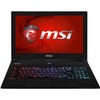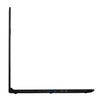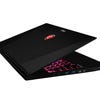MSI GS60 2PC Ghost with Nvidia GTX 860M review
Xbox One-beating graphics and desktop CPU power in a thin and light shell.
It's been some time since we reviewed the Razer Blade 14 - a unique combination of gaming-grade Intel and Nvidia components somehow integrated into an ultra-slim laptop chassis highly reminiscent of the MacBook Pro. It's a fine machine, if slightly anaemic in terms of its graphics power (boosted considerably in its latest revision) and handicapped by an ultra-expensive price point - not to mention a lack of general availability outside North America. So the quest is on to find a suitable replacement, leading us to MSI's GS60 2PC Ghost. It's not quite the like-for-like challenger we would have wanted - it's a lot bigger for starters - but it's significantly more powerful than the last-gen Blade and a lot cheaper too.
What we're looking at here is - according to MSI - the thinnest 15-inch gaming notebook on the market, with a case that's just 19.9mm high with the lid closed. Thanks to a magnesium chassis, it's also remarkably light too, weighing in at just 1.96kg. Despite this, it remains a fairly imposing presence - the GS60 Ghost has a 15.6-inch display and there's a pretty sizeable bezel there too, adding significantly to the overall footprint of the unit. On the plus side, this means that there is no real shortage of space for those all-important ports - we have HDMI and mini-DisplayPort alongside three USB 3.0 ports, line-out and microphone-in, plus an SD card slot too.
Chassis build quality is a mixture of brushed aluminium and plastic - not really on the same level as the Razer Blade - bolstered significantly by the real star of the show, the full HD IPS display. Colour is rich and vibrant, while brightness and contrast are excellent, and there are absolutely no problems with viewing angles whatsoever. In a world where laptop displays are still dominated by entry-level TN panels, the GS60 Ghost is a world apart - it looks quite beautiful.
Elsewhere, the all-important keyboard and trackpad are a bit of a mixed bag. Typing on the chiclet keyboard is a joy, but the touchpad is more pedestrian, somewhat unresponsive in comparison to the MacBook gold standard. The acoustic side of the overall package isn't exactly best in class either - packing so much processing power into the unit ensures that fan noise is audible even at idle, and kicks up into a much higher gear when gaming. Continuous looping of the Metro Last Light demo reveals maximum temperatures of 80 degrees Celsius on both CPU and GPU. Heat is dissipated effectively enough, but at the cost of audible fan noise.
But it really has to be stressed that you're getting some pretty capable kit here. In terms of the core hardware, we're looking at the Core i7 4700HQ running at 2.4GHz, with the potential to turbo up to 3.4GHz as long as thermal headroom allows. The GTX 860M found in the GS60 Ghost is effectively a downclocked desktop GTX 760, utilising the same version of the GK104 Kepler chip. This features 1152 CUDA cores clocked at 797MHz, boosting to 915MHz, albeit constrained by a 128-bit memory bus.
In actual fact, two versions of the GTX 860M are available - the Kepler variant seen here, along with a soldered-on version based on the new Maxwell architecture. Tests by respected laptop tech site NotebookCheck suggest that the more modern chip has an average 10 per cent performance boost over the version we're reviewing here (and up to 40 per cent higher in certain games).
CPU power is something we tend to overlook in our laptop reviews, so we wanted to address that by comparing the chip seen here with a bunch of desktop Intel i5 and i7 processors you may be familiar with. As you can see from the results, the i7 4700HQ compares quite favourably with a desktop i5, but falls short in the x264 video encoding test. Looking at Intel's Xtreme Tuning Utility, we see that the i7 4700HQ hits 3.2GHz on all cores during CPU-intensive tasks - not bad at all.
| Intel Core i7 4700HQ | Intel Core i5 3570K | Intel Core i5 4670K | Intel Core i7 3770K | Intel Core i7 4770K | Intel Core i7 4790K | |
|---|---|---|---|---|---|---|
| 3DMark 11 Physics | 6543 | 7269 | 7406 | 8708 | 9470 | 10480 |
| 3DMark Physics | 8792 | 6901 | 7787 | 10105 | 10757 | 12180 |
| CineBench Multi-Core | 6.82 | 5.97 | 6.57 | 7.83 | 8.58 | 9.62 |
| CineBench Single-Core | 1.41 | 1.56 | 1.71 | 1.65 | 1.73 | 1.97 |
| x264 (fps) | 13.55 | 11.98 | 14.22 | 15.02 | 16.92 | 19.07 |
| Aida64 CPU Queen | 40782 | 34210 | 37391 | 49310 | 49804 | 56204 |
But what about the GPU? Well, let's break out the first of our gameplay tests: DICE's Battlefield 4 running at the console-equivalent high settings. We ran through the same challenging sections of the campaign at three different resolutions - 720p, 900p and 1080p - and have a trio of video comparisons for you. In the main video below, you'll find that the only way the GS60 Ghost beats console frame-rates is to run the game at 720p, with the 900p set-up almost always beaten by both Xbox One and PlayStation 4. In the PC-specific comparisons, you'll see some moments of gameplay where frame-rates don't hit 60fps, and seem pretty close regardless of resolution - the chances are that we're hitting a CPU ceiling here.
At the silicon level, we've mentioned that the Kepler GTX 860M is a match for the GTX 760 - the graphics card that we chose for our sub-£500 Digital Foundry next-gen PC. It's an excellent GPU that can, by and large, hold a full 1080p60 presentation. We can only assume that the more constricted memory bus and lower clocks are having a big impact in this pared-back laptop implementation. We fully expected to sustain 900p at 60fps, in line with desktop parts like the Radeon R7 260X or GTX 750 Ti, but it was not to be. In short, we were looking for a part that could supply Battlefield 4 performance in line with - or better than - PlayStation 4, but instead we ended up with an overall performance level that just nudges slightly ahead of the Xbox One.
So there's good news and bad news, then: the GS60 Ghost and GTX 860M will have no problem running any PC title you care to throw at it, but the bad news is that you may need to reduce resolution if you're looking to enjoy gameplay north of 30fps. Therefore it's a bit of a shame that the brilliant 1080p IPS display can't be seen at its best on demanding software.
Alternative analysis:
Curiously, while Battlefield 4 underperformed according to our expectations, the GS60 did pretty well in tackling Crysis 3 - a game we ran at its challenging high preset with v-sync and SMAA T2x anti-aliasing engaged. A brutal workout for both CPU and GPU, we opted to play through the Welcome to the Jungle level at both 1600x900 and full 1080p, comparing the results in the performance video below.
While running at a sub-native resolution isn't ideal, the GS60 Ghost's display scales pretty well and a 900p resolution in Crysis 3 in concert with a 30fps lock (we recommend the frame-rate limiter in the Riva Tuner Statistics server - a part of MSI Afterburner) produces a rock-solid experience.
While the game often runs above 30fps on the high setting at 1080p, we'd actually recommend dropping down to medium if you must have a full, native presentation. The dips below 30fps really impact the feel of the game, with one section in particular seeing performance dip down to a sustained 20fps - that section is reminiscent of the disappointing frame-rates seen in the last-gen console version of Crysis 3 and unacceptably low for a fast-paced shooter.
Moving onto game benchmarks, it becomes clear that it's not just Crysis 3 that benefits from a drop down to 900p resolution - any graphically demanding title can't really be run at high settings at full HD resolution becomes viable at a lower resolution. Typical GPU hogs like Metro Last Light and Hitman Absolution fall beneath the 30fps threshold, though lighter titles like BioShock Infinite and Tomb Raider clearly do much better and make a good fist of handing in a perceptual 60fps experience during gameplay.
Overall, the GTX 860M is a good performer, but in no way spectacular. Despite its architectural similarities to Nvidia's excellent GTX 760, overall game frame-rates are actually more in line with a sub-£100 desktop graphics card. Indeed, even the £85 Radeon R7 260X - a card we consider to offer slightly better performance than next-gen console, based on launch title comparisons - hands in better Battlefield 4 performance than this. We can't help but wonder how the 860M variant based on the new Maxwell architecture would have compared to the Kepler version MSI has chosen to integrate here - the specs look almost identical to the GTX 750 Ti on desktop, a card that was very warmly received in its recent Digital Foundry review.
Certainly, there appear to be no battery life advantages to compensate for the slightly lower than expected performance - the GS60 Ghost hands in around 3.5 hours of low-intensity usage, dropping to around an hour of intense gameplay. That's par for the course for a gaming laptop, but the browsing/Office stamina is pretty poor in the age of the frugal Haswell processor. We can't help but wish that MSI had opted for a higher-capacity battery - the 52Whr six-cell battery here falls short compared to the 70Whr unit in the smaller Razer Blade 14, not to mention the vast 91Whr Dell XPS 15.
| MSI GS60 2PC Ghost | 1600x900 | 1920x1080 |
|---|---|---|
| Crysis 3, High, SMAA T2x | 49.6 | 37.3 |
| Battlefield 4, High, Post-AA | 45.2 | 36.3 |
| Tomb Raider, High, FXAA | 71.6 | 55.9 |
| Metro Last Light, High, SSAA off | 36.3 | 26.7 |
| BioShock Infinite, Very High, Post-AA | 65.0 | 49.0 |
| Hitman: Absolution, High, 2x MSAA | 36.0 | 29.0 |
MSI GS60 2PC Ghost - the Digital Foundry verdict
The GS60 Ghost is a sterling effort. While we wish that the overall footprint of the unit could be smaller, the laptop's low weight and thin chassis are the high points, bolstered by an exceptional matte 1080p IPS display that is great for both gaming and productivity. While it is aimed at gamers, the inclusion of a full Core i7 CPU makes this an ideal portable workstation, and the combination of a fast M.2 SSD along with a large 1TB mechanical drive offers the best of both worlds - a fast, highly responsive operating system but plenty of storage.
At around £1150 it's clear that the GS60 Ghost isn't cheap, but as an overall package it's pretty impressive overall - it's too large to be considered an ultrabook, but it's thin and light enough to carry around with you, packing more CPU and GPU power than many desktops and positively annihilates virtually anything in the same weight class in terms of raw performance. However, while the GTX 860M is a capable GPU in mobile terms, it offers nothing like the raw gaming power found in the MSI GT70 2PE Dominator we reviewed recently. The advantages of the lower price point and the thinner, more portable chassis have to be offset somewhere and it's in the reduced GPU power that the GS60 2PC Ghost makes its trades. That said, the likes of Battlefield 4 and Crysis 3 are still perfectly playable - you just need to accept lower frame-rates or reduced resolution.
However, other GS60 options are available - a Pro version of the unit with a more capable GTX 870M is out there that adds around £170 to the purchase price but should boost frame-rates by around 40 per cent, along with a "3K" variant that retains the higher-end GPU, but swaps out the full HD panel for a 2880x1620 display. It sounds enticing but also rather expensive - and it's not out in the UK yet.
So the quest continues to find a gaming laptop that outperforms the Razer Blade 14 in a similar form factor while significantly undercutting it on price. The MSI GS60 Ghost 2PC isn't quite that product but it gets close in a lot of areas with its lightweight design, brilliant screen, i7 processing power and enough GPU grunt to power past Xbox One. It isn't quite the perfect gaming laptop we'd want to drop a grand of our hard-earned on, but it more than fits the bill as all-in-one machine that could replace your desktop.








